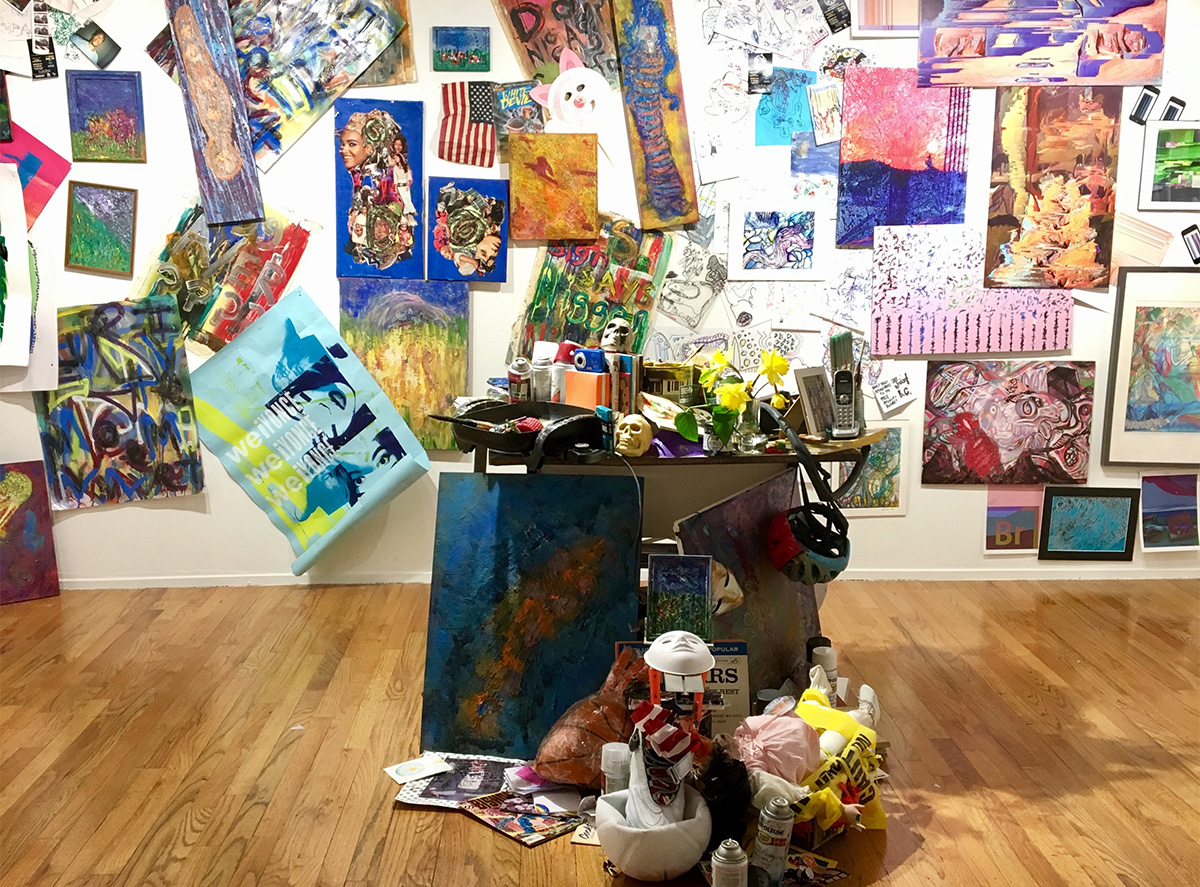
“5 Questions” is an ongoing series with School of Art alumni who are transforming art, culture, and technology, exploring their creative practices, career milestones, and Carnegie Mellon memories.
Jules Mallis is an intermedia artist and community leader. They are the Executive Director at Repair The World Pittsburgh, a Jewish social justice organization connecting communities in meaningful service-learning programs.
Mallis performs live as a VJ and DJ and uses digital media, paint, installation, performance, sound and audience interaction to create unique creative and enriching experiences. Their artistic production focuses on building community, audio-visual experiences and speaking truth. They have exhibited, performed and curated art across the United States including at The Andy Warhol Museum, The Carnegie Museum of Art, The Pittsburgh Center for the Arts, Coaxial Arts Foundation, PhilaMOCA, MOCA Cleveland, Baby’s All Right, The Silent Barn, Fringe Arts and more.
1
Do you see a connection between your work with Repair the World Pittsburgh and your art practice? How does your art practice influence your work in social justice and vice versa?
Great question. I think the key words here are ‘practice’ and ‘context’. At Repair The World, we are working to quite literally repair what is broken and to support community initiatives in the ways that are attainable right now as an organization and as individuals. We organize to leverage our resources together to address urgent community needs. The work is ongoing due to structural issues and we are engaging in a practice of repair. Our work at Repair also prioritizes contextualizing what we do, by sharing educational info about the issue areas we seek to address, such as food justice and its intersections. Our work could lack meaning without contextualization. This is where I feel it intersects most with my creative practice. The role of the artist is in part to contextualize what is happening in our world. Artists use creative tools of communication and media to change the world, inspire, provide commentary and make connections. Both are an ongoing practice, a conversation between ourselves and the community, a response to what the world is saying, feeling and sharing, and a way to make sense of it all. I have the flexibility to bring some art and creative media into our work at Repair, by hosting community art exhibitions like “Stones and Roses” and “Hitchazkut: Strengthening Each Other in Pursuit of a More Just World“. In my creative practice I can also push forward ideas that are important to the communities that I am part of and further highlight topics of urgency and importance.
2
Some of your work seems to bridge the gap between night life (for example, your collaborations with girlfx and hot mass) and “fine art.” What is it like to bring your art background into spaces not usually thought of as presenting artwork?
Nightlife is way to share art in context, in real time. To build authentic experiences and contribute to the culture and ideally to the community. It can help to facilitate relationships and intercommunity building and create space for personal reflection and growth. With any space, industry, or public program, there are pros and cons and a multitude of experiences and histories at play. Bringing art into spaces like this is an act of intentionality and critical thinking, where exploitation and abuse can easily run its course. We get to help shape communal experiences and ideally pave way for something that can be cathartic, beautiful, reflective and open for personal processing. Done well, the experiences will honor history, respect local communities and help shift power dynamics in support of individuals who have been pushed into marginalization. In a city like Pittsburgh, with a terrible history of racism, colonialism, anti-semitism, white supremacy, pollution (and so much more at play), there is a lot of work needed to shift power dynamics and support a thriving culture.
3
Since a lot of your artwork is predicated on live experiences, how did COVID change how you thought about your practice and connecting with audiences?
I have an exhibition on display at the Kelly Strayhorn Theatre now through December 17th, 2022 – Marking This Moment: BOOM Capsule alongside DS Kinsel and Thomas Agnew of BOOM Concepts. Each of us sought to represent a slice of how artists, musicians and individuals experienced the first year or two of COVID by sharing first-hand perspectives. For my part of this work, I presented a visual anthology and mixtape featuring 9 artists/collectives. The artists and artist collectives reflected in the anthology have demonstrated new ways of utilizing visuals, video, and visual imagery to tell their stories. The anthology highlights the renewed focus on visual media within a larger audio-visual landscape, exacerbated by COVID-19, and how the pandemic affected our experiences of interaction, engagement, communication, and the intake of media. Go check out the exhibition to further explore this question.

4
Could you talk a bit about your time as an undergraduate at CMU’s School of Art? Are there any experiences you had as a student that stand out?
School is challenging to navigate with so many power dynamics and tensions at play. It can certainly be a lot for anyone to experience. I feel that I did not know how to be a good student until I was a junior and started getting regular sleep, eating three meals/day and creating good boundaries in my life to best balance work, life, personal wellness and social time. I pushed myself to take classes with professors again even if I did not perform well or have the best experience so that I could “try again” and redefine my relationship with that topic and/or professor. This strategy was very successful and imparted a great sense of closure and growth, because I allowed myself the opportunity to do it over. For professors whom I really resonated with (in craft, or thinking, or otherwise) I tried to take as many classes with them as possible – professors like the late Lowry Burgess and Suzie Silver. Some professors I never got to take a class with, but was still able to develop meaningful relationships with through our other interactions and that is so valuable. I worked A LOT of jobs as a student, including at the Miller Gallery, the School of Art office, and tons more, which helped me to further build relationships with faculty that I didn’t get to work with in school.
5
Do you have any advice to share with students?
Believe in yourself and continue to develop your creative style and voice. Instead of always creating something new or working on new ideas, consider dipping back into an old idea and trying to do it again. You may have improved your skills or have found a new way to execute the idea at hand. This is something you can do throughout your life as an artist. Keep returning to yourself and your own works as inspiration for future projects and ideas to pursue further. Also, collaborate and work with others. Something magical can happen when you work together and exchange in creative dialogue.
Image of Jules Mallis by Ohad Cadji




